story and photography by Clement Salvadori
The road unrolls rapidly before me, the endless ribbon of two-lane blacktop smoothing out the hills and curves, disappearing around an oak tree, straightening briefly, then angling left and up. As it crests it slides right and down, and I drop a gear and apply a light brake. Perfect asphalt, freshly laid through hundreds of acres of vineyards, and no traffic to speak of.
The Kawasaki Concours and I are a pair, whisking along in third and fourth gears, rarely going over 6,000 rpm. No need; this is such a strong engine that it pulls quite satisfactorily from 3,000 on. I’m not out to win a race, just enjoying the lean angles and the occasional immoderate speeds.
Not that the Concours is a modest machine; with 130 horsepower at the rear wheel (see Rider, November 2007), this baby can go a lot faster than I care to. I’m happy using half the power, half the torque, though it is always nice to have the other half there just in case I want to overtake that 18-wheeler lumbering up a steep hill. The power is all there in my right hand, and more is better than less.
I begin the day by coursing out through Vineland, as I call the grape-growing area around Paso Robles. Close to 200 vineyards are competing with Napa Valley for oenological dominance, and one of the great advantages is that new asphalt has been laid through much of this expensive land, and unless it is harvest season there is nobody out there. A little weekend traffic with tourists going to the tasting rooms, but on this Tuesday the road is mine, all mine.
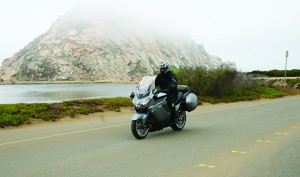
I’m trying out the Kawasaki Concours 14, a very worthy successor to the long-lived ZG1000 Concours, one of which I bought more than 20 years ago. A comparison would be fun, but I am not into doing that today. Just putting lots of miles on the C-14. Great brakes on the bike, which has the ABS option, a well-spent $900 in my mind. The front and rear are not linked, such linkage having become a matter of debate in recent years; to me it makes no real difference, since I use the pedal and the lever simultaneously.
I’m east of the little mission town of San Miguel, heading west, and as I come around the last little hillock on Cross Canyon Road I see the Salinas River in front and the San Miguel Mission a mile away on the far side. The tripmeter is only reading 43 miles, and the gas tank is rated at 5.8 gallons. I also have learned that when the LOW FUEL warning comes up on the dash I have a gallon left. However, since I am not going to see any gas stations for the next 150 or more miles, I’ll err on the side of caution and detour into San Miguel.
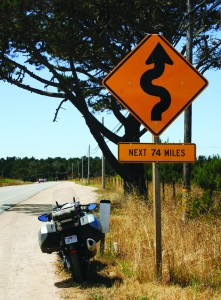
The dash does other things as well, like tell me average mpg (about 35/36 for the 1,500 miles I eventually put on the bike) and current fuel consumption (99.9 mpg as I come down a hill and back off completely on the throttle), and my favorite, the tire pressures. All touring bikes should have this indicator, as too many touring riders do not check tire pressures regularly enough—often because the Schrader valve is just too darned difficult to access.
Kawasaki has gone automotive with the ignition system, and I keep the little electronic transponder fob in my pocket, leaving the key in the ignition when parked. Without the fob the key cannot turn the ignition, except I usually have something I want to get out of a saddlebag, so I do pull the key out at most every stop. Including when I need to add gas.
I head up Indian Valley Road, with maybe two dozen ranches in the next 45 miles. Knowing that this road is not well maintained, back at the house I fiddled with the suspension just a little. Standard setting is for a 150-pound rider, and I, wanting a comfy ride and weighing 220, only upped the spring preload and compression damping fore and aft a little bit north of standard. Adjustments on both the fork and the Uni-Trak single-shock are very easy to make.
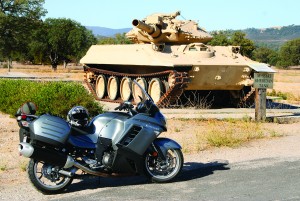
Indian Valley is fun, a bit bumpy in spots, and effectively becomes one lane of asphalt. But in those 45 miles I pass one pickup. The road has an ideal number of curves and rises as it runs up a valley, crosses over a saddle and descends into Peachtree Valley, paralleling the San Andreas Fault, viewable as a large chasm lying off to the west side.
I reach CA 198, which runs east/west between Interstate 5 and U.S. 101, and is well cared for by the estimable CalTrans workers. The long ascent going east from the valley to Mustang Ridge is an absolute delight, the C-14 in its very sport-touring element. The tires, Bridgestone Battlax BT021s, grip marvelously well. The essence of sport is the lean, and I am probably reaching 40-degree angles as I whisk up the hill. Then it is through Priest Valley and down toward Coalinga. Ten miles west of Coalinga I come to Parkfield Junction, where the Parkfield Grade goes off to the right, with a long climb to the top of Parkfield Mountain. There must have been some guy named Parkfield, but not even the Internet has given me a lead. The single-lane road, built to take wagons back in the 1890s, has been newly paved thanks to the largess of Fresno County, and this road is second- and third-gear work. At the top the road enters Monterey County, which has not seen fit to lay pavement on top of the dirt. But it is a good dirt road, and only 3.5 miles downhill into Cholame Valley before it returns to asphalt.
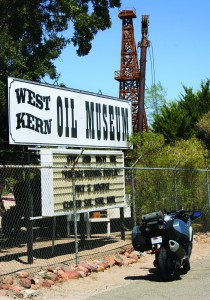
There is the Parkfield Inn & Café, centerpiece of Parkfield, Earthquake Capitol of the World, population somewhat less than a hundred, where a tri-tip sandwich and glass of lemonade awaits me. A sign reads, “Be Here When It Happens,” but no earthquake shakes me as I eat and write notes. And eventually head home along Cholame Road and CA 41.
I know that “engine heat” has often been an issue on some of these new, powerful sport-touring machines, but to me it is a minor factor on the C-14. The temperature is 90 degrees this afternoon and I do notice that at speed a certain amount of heat comes through the side panels, which I can feel between my ankle and knee. But I have boots and riding pants on, so it is quite tolerable, never hot enough to be a bother, like with some bikes I have been on that have made me ride with my legs splayed.
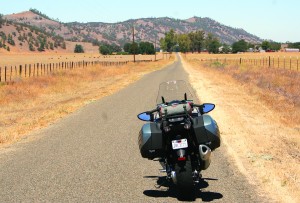
I get home with some 200 miles added to the odometer. For this story I am essentially using my house as a touring center, doing three day-long trips, east, northeast and north. I have been on all of these roads before, which makes riding the C-14 that much more pleasurable—I know where all the decreasing-radius curves are, allowing me to enjoy the motorcycle to my maximum. Not the motorcycle’s maximum, that is for sure, as it can go way too fast for the likes of me. As a friend is wont to say, there are three speeds: slow, fast and absurdly fast; I’m in the middle category.
Next day I head south on U.S. 101, a rather busy highway that runs 1,500 miles from Los Angeles all the way to Olympia, Washington. But I’m only doing 45 miles, from CA 41 down to CA 166, close to the town of Santa Maria. CA 166 is another of those east/west connectors, with a modest amount of traffic as trucks full of produce from Santa Maria head over to the Central Valley, and runs alongside the Cuyama River. Most of the year the river is dry, but in a wet winter it can be very wet indeed, occasionally washing out a bridge or two along these 65 miles. It’s a good road, with rather gentle curves, which is why truckers like it. As opposed to CA 58, which I’ll be on in an hour.
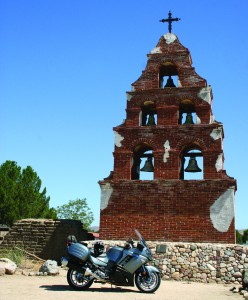
The engine on the C-14 is everything but peaky, and its Variable Valve Timing sophistication is totally unnoticeable. Sixth gear (OD on the dash) is good for any speed from 50 mph on up; there is probably not a curve on CA 166 that could not be comfortably negotiated at 100 mph, but since the road is often patrolled by California’s finest I maintain a more acceptable speed. For fun I am shifting between fourth, fifth and sixth, but I could have just left it in sixth. I am told that the C-14 has what is commonly known as a “slipper” clutch, easing downshift problems when the revs are not properly matched, and I can only pay it my highest compliment by saying that I never noticed it.
I have the electrically operated windscreen set at 90 percent of its height, which is the most comfortable for me at 6 feet, 3 inches. It is noisy for me behind the screen, but Kawasaki offers an optional larger version. And the aftermarket may come into play as well.
The road straightens as it passes New Cuyama and (old) Cuyama, hooks into CA 33, and they continue together up over the low 2,968-foot summit and then down the nine-mile-long Grocers Grade to Maricopa, 854 feet above sea level. A couple of emergency run-offs for the 18-wheelers are along the grade; I actually coasted the whole thing years ago when I ran out of gas at the summit.
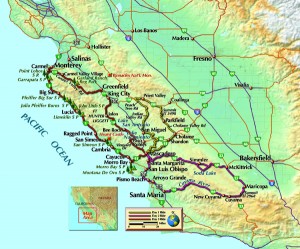
We stay on 33 going north, where much of the local monies come from speeding tickets. A lot of oil production lies along the next 30 miles, in the Elk Hills, part of the infamous 1923 Teapot Dome scandal which brought disgrace to the administration of President Harding. The place is still pumping a lot of petroleum product out of this ground. We continue on to the McKittrick Hotel, centerpiece of the almost-vanished town of McKittrick, where a chicken-fried steak soothes the pangs of hunger, my having left home with naught but a cup of coffee.
After breaking my fast I hook into CA 58, one of the most delightful roads in California. It is 75 miles of motorcycling bliss, beginning with a seven-mile climb up to the 3,258-foot Temblor Summit, then across the Carrizo Plain, with a side trip to Soda Lake. Then it is 50 miles of ranchland, weaving through the multitude of small valleys and ridges in between—and maybe one vehicle every five miles. It is a well-maintained and little-used road, and a delight to ride, playing a slow tune on the gearbox. With all that power over all that range I don’t have to shift that much, not like running my wife’s Ninja 500 on the same route. We end up in the little town of Santa Margarita, eight miles from my house; 250 miles all told.
I have a couple of complaints about the new Concours. One is the lack of fairing protection in the event of a parking-lot tipover or low-speed spill. I remember too well the day the old Concours fell over, breaking off the whole left-side foot bracket, leaving the bike unrideable; I did not duplicate the experiment with the C-14, but it looks a bit tender. Cruise control and heated grips would be nice options, too.
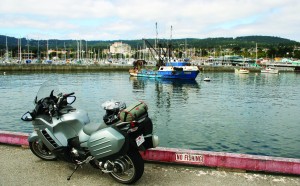
My third loop is around the Big Sur, 300 miles of fabulous riding. I begin by going along the small roads through vineyards and olive-tree orchards west of Paso Robles, pick up G14 at Chimney Rock, cross the dam at Lake Nacimiento, and I am on Interlake Road, 20 miles of generally uninhabited happiness for any motorcyclist. From a ridge above the lake I take a fast, downhill 180-degree sweeper into Rock Canyon, then past the little Bee Rock Store, along Harris Valley, heading north as fast as I would like to go. Weekends there may be a few vehicles, weekdays virtually no one. Left, right, up, down, right, left—endless variations of good blacktop.
I come up to Lockwood, turn left and pay attention to the speed signs, as G14 passing Fort Hunter Liggett acquires “concurrent jurisdiction status,” meaning that any bored MP or federal cop can pull me over. G14 ends at U.S. 101 just west of King City, but after two miles I turn off U.S. 101 onto Central Avenue, which runs flat through fertile fields to connect with G16, which will take me 50 miles all the way to Carmel with a great many twists and turns along the way. The road can be a bit rough in places, but the C-14’s suspension, which I have left on the softish side, soaks most everything up. Mostly it is just me and the motorcycle and a few cattle looking on curiously.
Running over to Monterey to get some fish and chips on the wharf, I sit and eat on a bench while listening to the sea lions bark. Then the tank gets filled and we head south on CA 1 into Big Sur; it is a summer’s afternoon, and I know that there will be some tourist traffic. But with 130 horsepower at the rear wheel, I can slip by a motorhome in less time than it takes to say “Winnebago.” It is a clear day, and I am happy pretty much loafing along, over Bixby Bridge, around Hurricane Point, marveling in the views.
After Pfeiffer Big Sur State Park the traffic thins out and I pick up the pace heading for Lucia. Then the inevitable summer construction appears, but that is quite useful. Thirty cars are backed up, and I just slide by the lot, leaving me with an empty road ahead. Delightful. Of course there is the oncoming left-turning idiot, but the excellent brakes slow me down without any nervousness.
Now I am past Ragged Point, dropping down to the coastal plain, passing Hearst Castle, Cambria, Cayucos, and finally turn onto CA 41, which goes close by my house. No doubt about it, this C-14 is a serious contender in the sport-touring class.
[From the December 2007 issue of Rider]






